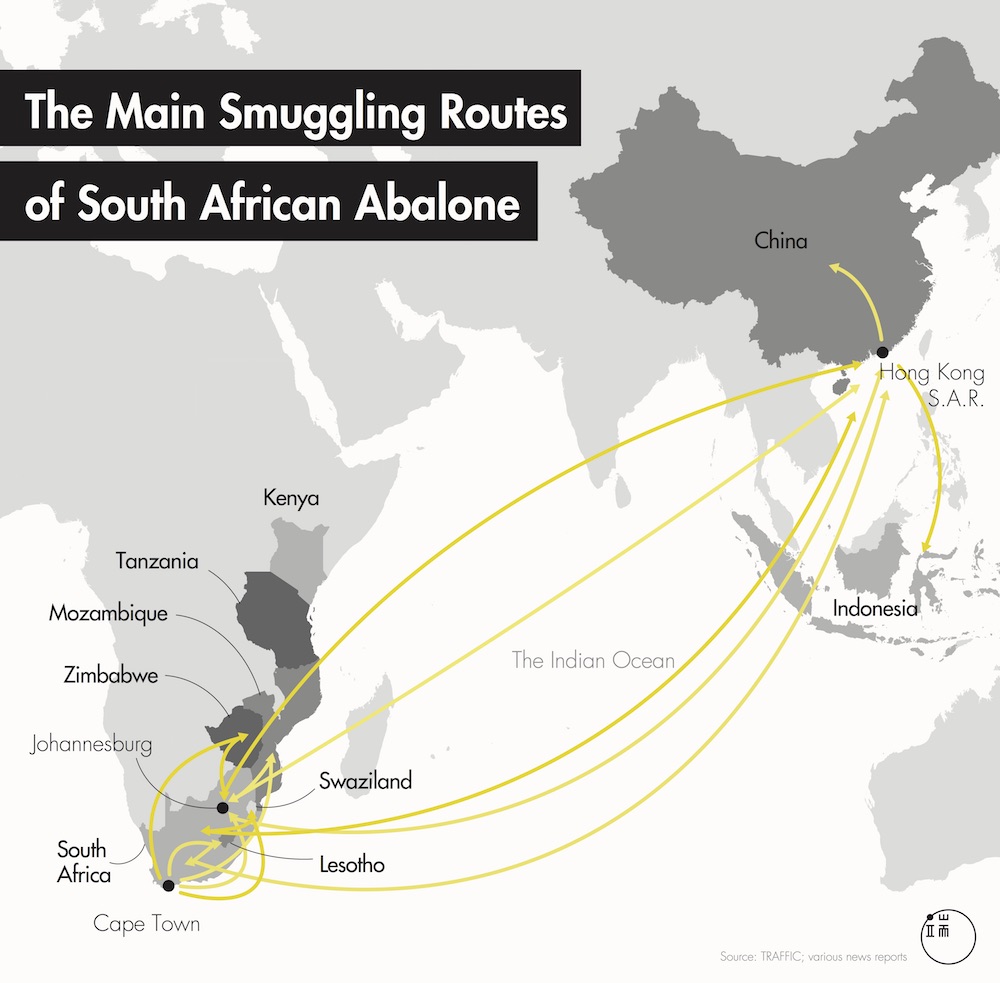
09 Jun How SA’s abalone ends up on China’s plates
Crystal Chow investigates how the race over the most sought-after delicacy in Asia embodies the developmental dilemma in post-apartheid South Africa
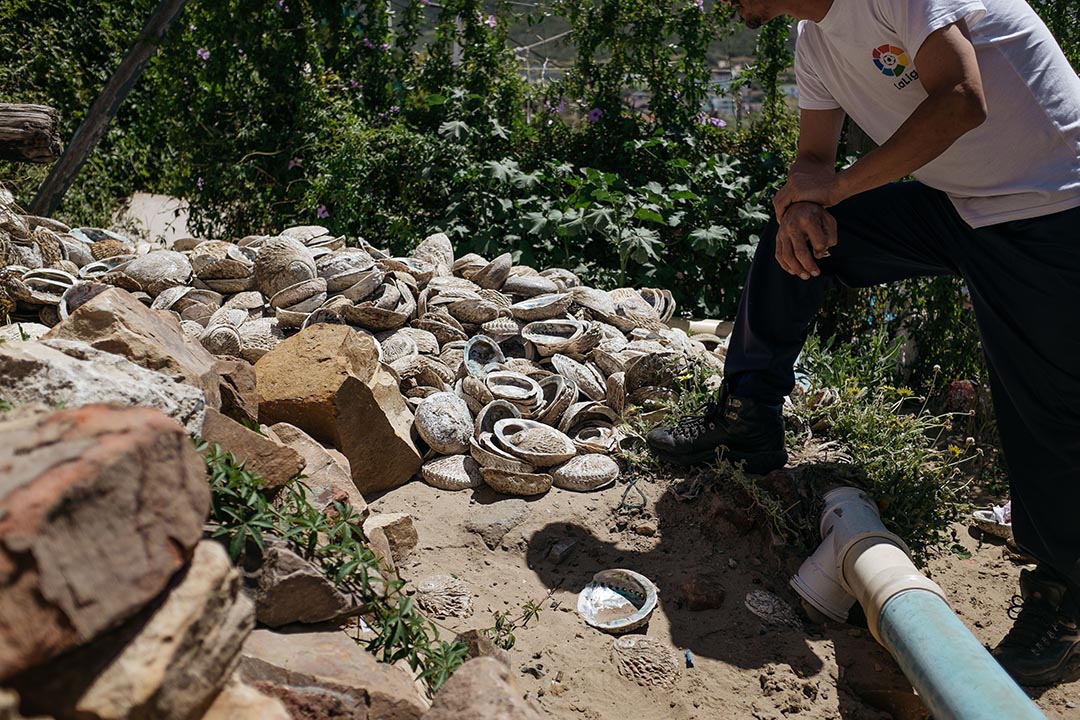
A Hangberg fisherman surrounded by hundreds of empty abalone shells that he and his companions caught over the preceding week. Photos: Crystal Chow
Abalone tops the list of the most exquisite seafood in Chinese cuisine, and fresh South African abalone are always the first choice for feasts in Cantonese restaurants, where one fresh abalone alone can cost up to HK$2,000 (about R3,000). In recent years, the overfishing and smuggling of wild abalone has pushed this endemic species of the South African coast towards extinction.
“The South African wild abalone are heavier, and they are better than the farmed Japanese and Australian ones in terms of fresh flavour and texture,” said Chit-yu Lau, general manager of Ah Yat Abalones restaurant in Hong Kong. “Our fresh South African abalone are all imported through legitimate channels. The smuggled ones are usually dried, and are rare in Hong Kong.”
Nonetheless, the illicit abalone trade has been gathering significant attention from conservationists combating wildlife trafficking, who believe the profitable contraband market of abalone is linked to the black market of ivory and rhino horns – both of which are driven by high demand from the Chinese market.
In the “old Chinatown” in downtown Johannesburg earlier this year, only a few Chinese restaurants were open and there were few pedestrians on the streets. It was hard to imagine the neighbourhood used to be the main settlement built during the 19th century “gold rush” by Chinese labourers who settled in South Africa.
Today the remaining shops have put up heavy gates and anti-theft devices due to worsening security in the neighbourhood, while many Chinese shop owners and new Chinese immigrants set up another Chinatown, along Derrick Avenue in Cyrildene, and funded the establishment of two traditional Chinese archways there.
The older generation of Chinese immigrants, who still stay in the old Chinatown, are mostly from Panyu or Shunde area in China’s Guangdong province. Their children, who were born in South Africa, have gone through tertiary education and started up businesses thanks to the abolishment of apartheid in 1994. The Overseas Chinese Association office in the old Chinatown, which still functions as a clubhouse for social meetings, has witnessed how Chinese residents have progressed beyond second-class citizenship in South Africa.
Perhaps because community status and dignity are hard to come by, these “old immigrants” seem to distinguish themselves from those Chinese who allegedly engage in illegal activities. In the Overseas Chinese Association office, a woman in her 60s told me in Cantonese: “The black market for abalone is illegal, so Chinese here will neither speak about it nor easily introduce you to the insiders.”
The president of the Chinese Association in Gauteng, Erwin Pon, said, “As the government has strict control over abalone, only one or two licensed restaurants can legally procure and sell fresh abalone. As for smuggling activities, I think most of them are related to the new immigrants.”
In the “new Chinatown” in Cyrildene, an underground market for abalone booms. In one of the seafood wholesale shops, I asked a salesgirl for the price of dried abalone. The young woman, who came from Fujian province in China, told me bashfully, “We don’t sell abalone.” But as I was leaving, a middle-aged man who was sitting next to the cash register suddenly began to speak: “Abalones are R1,400 per kilo, and you have to buy at least five kilos. You can collect them after 5pm if you buy.”
At the other end of the street, where I again posed as a customer, the owner of another seafood wholesaler wrote down a phone number on a blank receipt. “Abalones are about R1,200 per kilo, they are more expensive than before. I’m not at liberty to give you the address, but if you want abalones, you can call this number. I don’t know his name though – we only call him xiaodi (‘little brother’).”
How extensive is the transaction chain and how big is the market? How is South African abalone, also known locally as perlemoen, taken from the sea reefs, processed into dried abalone, smuggled into cities, and then shipped to the other side of the ocean?
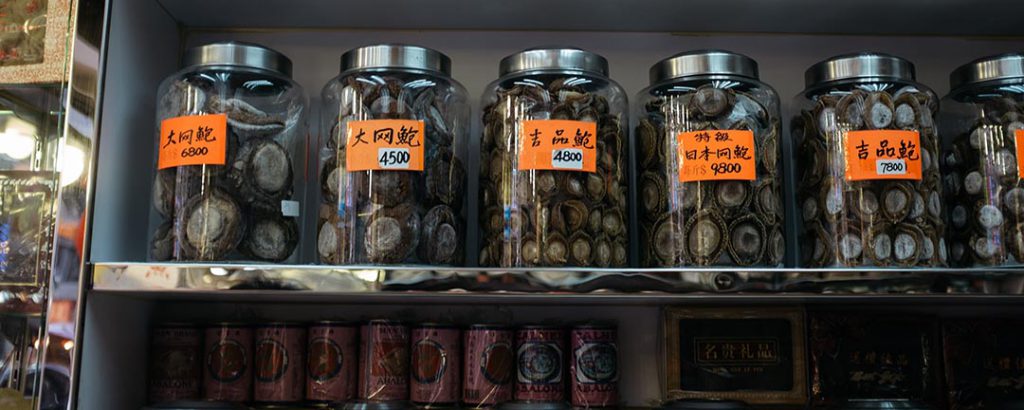
Dried South African abalone on display in the ‘seafood street’ in Sheung Wan, Hong Kong
Currency in the black market
In the run-up to the Chinese New Year in January, many old-style seafood shops were selling dried abalone from different origins in Wing Lok Street and Des Voeux Road West area, commonly known as the “seafood street” in Sheung Wan, Hong Kong. The dried abalone from South Africa was priced per kilo and in accordance with size.
One seafood shop owner, Mr Lee, said he hadn’t heard any of his peers selling smuggled abalone: “The smuggled ones are not necessarily cheaper, and they would get you into trouble. It isn’t worth the risk.”
A clerk at another wholesale seafood shop around the corner also said abalone smuggling was “never heard of”, and insisted that their supply was completely legitimate.
The trade data, however, indicates otherwise. Having analysed the Hong Kong imports data, Markus Burgener, head of the East African and Southern African division of international conservation network Traffic, found that more than 30,000 tons of dried abalone had been imported from the region into Hong Kong since 2001 – totalling 10 times more than the South African government’s total allowable catch of abalone for the same period.
The big gap suggests a large number of dried abalone is smuggled into the Hong Kong market and re-exported to other Asian countries. It indicates that the South African abalone bought by Hong Kong consumers is most likely from illegal channels. Also, consumers and even some wholesalers may not be able to distinguish the source.
The South African Department of Agriculture, Forestry and Fisheries estimated that the amount of illegally harvested wild abalone went up from four million in 2008 to seven million last year. The quota system for total allowable catch is ineffective and the government is simply unable to stop the illegal catch.
In 2007, due to increased levels of illegal poaching, South African abalone was listed on Appendix III of the Convention on International Trade in Endangered Species, but the listing was withdrawn by the government after three years, reportedly due to difficulties in implementation.
Organised crime groups
The ecological crisis of South African abalone began to take shape in the 1970s, when the government introduced the quota system and criminal penalties to ensure that the populations of wild abalone remained stable. However, the apartheid regime created a white dominance in commercial fishing, excluding the traditional “coloured” fishermen, who were prompted to defy the law and join illegal fishing.
As border controls relaxed gradually after the late 1980s, organised crime groups led by Chinese and Asians began to exploit the market gap to recruit in the coastal areas for illegally smuggling captured abalone. They continue to control the lucrative black market.

The main smuggling routes of South African abalone. Source: TRAFFIC; various news reports. Image: Design Desk of The Initium Media
Since then, the number of wild abalone in South Africa has been plummeting, forcing the government to lower the total capture quota accordingly. The recreational licence system introduced in 1983 had to be abolished after 20 years as ongoing patterns of abuse persist.
At the forefront of illegal abalone fishing in a small coastal town called Betty’s Bay, 76-year-old Mike Tannet was flipping through a black leather notebook filled with case records.
“I started diving when I was 12 years old. After I grew up, I dived around the coral reefs on the coast of Western Cape and was shocked to see abalone becoming less and less,” he said. “A lot of abalone is being poached prematurely, which directly impedes their reproduction. Meanwhile, seaweed surges due to the absence of ‘predators’.”
Seals find it easier to hide in the seaweed from sharks, and in the long run hungry sharks will have unpredictable impacts on the entire marine food chain. The abalone are a small piece of a far larger puzzle which may be able to tip the balance of marine ecosystems.
Disturbed by what he saw as the consequence of unfettered poaching, in 1995 Tannet and several volunteers formed an organisation called Sea Watch to monitor abalone poaching along the coast, and set up a “hotline” for people to call at any time to report offenders. On various occasions, they have driven out to the scene to stop poachers.
“Over the past 20 years we have documented about 6,000 incidents of poaching,” said Tannet. But their work comes with considerable risks: Tannet and his wife have been physically attacked by poachers, who are believed to have ties to gangsters, and a few volunteers nearly had their homes burnt down.
Emphasising the lack of proper legal enforcement to curb abalone poaching, Tannet said: “They usually come at night, equipping themselves with weapons and motorboats. Sometimes even the police are unable to fight back and dare not chase them.
“I believe that some police officers are involved, and coordinate with poachers to let them flee the scene. Even if they are arrested and prosecuted successfully, the penalties are only fines or very short prison terms, which are far from a deterrent.”
Traffic’s Burgener said there are several means of smuggling dried abalone all the way to Asia: “As far as we understand, there are two main ways for having dried abalone smuggled out of the country and into Hong Kong and China. The first is to smuggle them into a few landlocked neighbouring countries where there is no regulation over the trade of abalone, say Mozambique or Zimbabwe, and then ‘import’ them back into South Africa before exporting them to Hong Kong under falsely declared origins.
“The second way is to have the dried abalone stored in a warehouse before they ship it off, or have it transported to Hong Kong by air, either by using fraudulent documents or bribing certain people in the customs.”
Drug gangs
Numerous reports suggest abalone smuggling has fuelled another raging criminal economy in the coastal communities controlled by gangsters in the Western Cape: drug trafficking and distribution. In 2009, the South China Morning Post cited evidence that drug gangs from Hong Kong and mainland China had been working with their South African peers to smuggle dried abalone into Hong Kong.
“There is an ethical aspect to the issue here. A lot of fishermen take risks to poach for gangs because of the limited job prospects in the community. Once they start, it essentially means they have signed a contract with drug lords. They cannot stop but end up being enslaved, even their family are controlled by drugs,” Burgener said.
In other words, smuggling abalone not only drives the species towards extinction, but also helps facilitate a transnational black market trading chain controlled by syndicates.
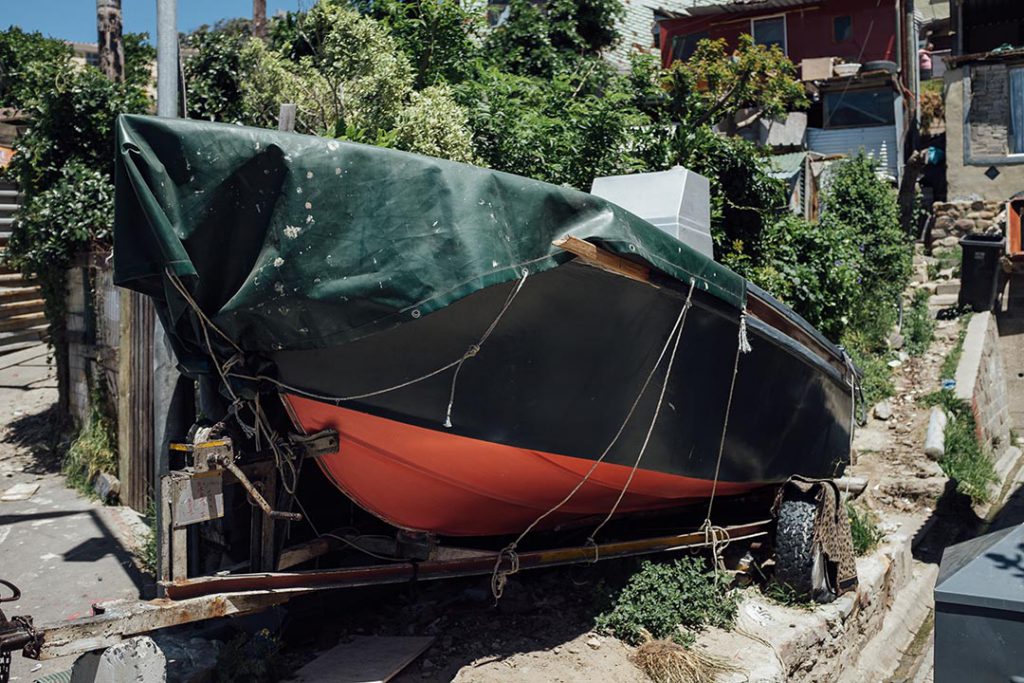
Ethical issue: ‘A lot of fishermen take risks to poach for gangs because of the limited job prospects in the community. Once they start, it essentially means that they have signed a contract with drug lords’
Fishermen-turned-abalone poachers
In the city centre of Cape Town, posing as a customer, I saw palm-sized wild abalone for sale in several upmarket Chinese restaurants, each priced between R2,000 and R3,000. One of the waiters eagerly showed me a big abalone resting in the store’s fish tank: “I think it may be 60 years old.”
South of the city centre is a community called Hangberg settled along the hillside of the coastal town Hout Bay. Louis (a pseudonym), a local fisherman, makes a living off illegal abalone fishing. He said he only earns R200 per kilo, often at the risk of getting caught or, worse, losing his life.
“Sometimes we deal directly with the Chinese guys, and they usually pay us more, around R350 to R400 per kilo. But for us, it is still safer to deal with a familiar local middleman instead,” Louis said. “It works like this: we get abalone and then we call the middleman to arrange pickups and pay us. And that is it. As for what factories the abalone would be delivered to, or whom they would be sold to, I just don’t want to know.”
His returns haven’t increased in accordance with the soaring market price. “Only the middlemen get rich,” he lamented, pointing to his slightly shabby living room. “Look, I started fishing for abalone 15 years ago, but I have always been living in houses like this. Those middlemen, including white guys and Chinese guys, own bungalows and fast boats. And we still have to buy everything we need and maintain all our equipment.”
The poachers struggle to provide for their families on their meagre income. “We work as a team. Every time about seven of us go to fish and what we earn has to be divided by seven families. If we do not work, our children will go hungry.”
Louis’s kitchen and bedroom were separated from the living room by a curtain. A fishing net was placed next to the refrigerator in the kitchen. Two children, about six or seven years old, were preparing lunch for themselves and their puppy. From the small window in the kitchen, one could get a glimpse of the harbour and the picturesque view of the coastline from afar. But the view did not belong to them.
“When the system fails you, you have to create your own systems,” Louis said.
He rejected the common perception that poachers are drug addicts. “I know there are ports in Western Cape that are controlled by gangs. But look, we work so hard simply to make a living. We have kids to feed. How could we have extra money to buy drugs? We need to dive and we need to maintain our normal body conditions. How can we possibly take drugs?”
In order to steer clear of police patrolling, poachers equip themselves with diving gear and head torches and ride the night waves out to sea. The dangers were not as frightening as being caught by police, though. “They will beat you and take everything away. Sometimes they even use rubber bullets on us, or hit us with a rifle,” Louis said. “Here we have a peaceful community, and not even the triads come to our bay. The only source of violence comes from the police.”
An older companion, Kopano (a pseudonym), cut in: “To us, fishing is the only way to make money. Fishing is the world we know and is our ancestral right. We should be able to fulfil all the criteria, but almost all of the quotas go to big companies, and laws are put on everything. Why does the government not recognise our rights? If we have the rights, we will look after the resources of our waters way better than the government.”
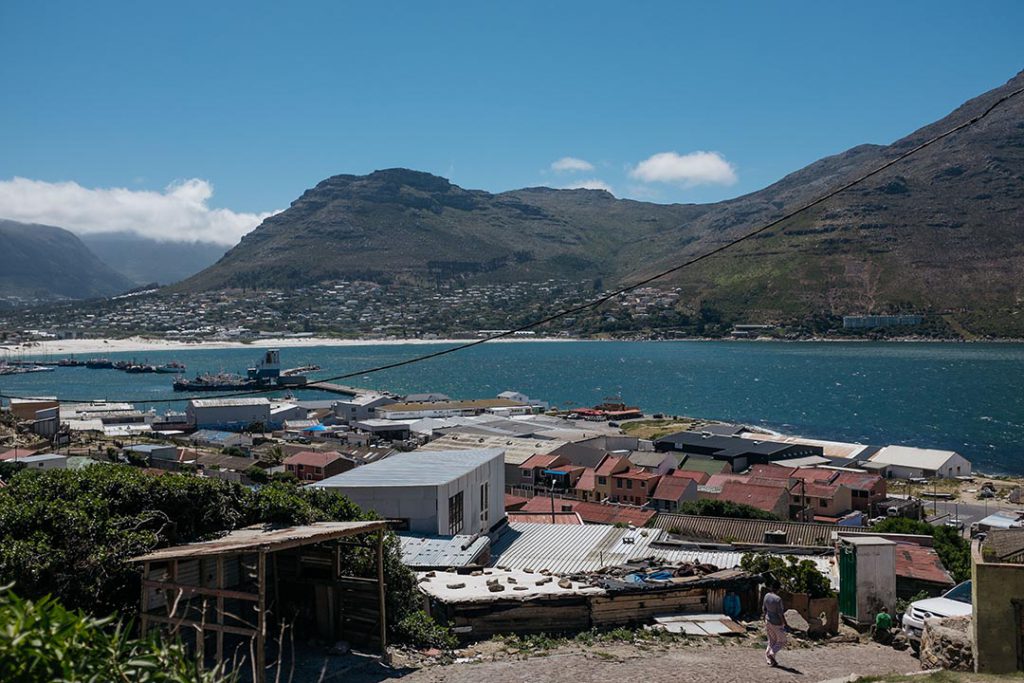
A view of Hout Bay port from Louis’s house in Hangberg. ‘We never call ourselves poachers. We are all fishermen, the aborigines,’ said his companion
A consequence of apartheid
Kopano said bitterly that those who first dived for abalone were the whites. “There was a white policeman who did so and got rich, owning a big house and cars just outside of our town. During apartheid, white people got away all the time. But when we have to do the same just to make a living, they start labelling us.”
He said about two decades ago, they all worked for big fishing companies as subcontractors. “Every three months we were told to leave. We tried to fight for better wages by organising a strike, and they just fired all of us. They thought we ‘coloured people’ were getting a little bit too wise. Now, the majority of workers at the ports are migrants from Congo or Zimbabwe because they are more than willing to take any jobs at wages even lower than R100 per day.”
Louis, Kopano and their friends started to make a living off abalone poaching in the early 2000s. “The saddest thing for us is that most people do not know we had never dived for abalone before that. We did not even know how much an abalone would cost,” said Louis.
He recalled how he got involved when he was still a high school student: “At that time there was a big-name white guy around Hangberg. One day I was on the coast and saw him fishing for crayfish using a speedboat. There was even a guy on the boat cooking the crayfish for him as lunch.
“Then he approached me and asked if I wanted to dive for abalone for him. After I was done, he asked me, ‘are you coming tomorrow?’ while holding four big bags of the catch.”
During apartheid, Hangberg was a segregated zone set up for coloured people. Louis and his friends used to frequent the reefs of Robben Island, where Nelson Mandela and other political prisoners were once imprisoned for their cause. Yet their vision of an equal and prosperous nation remains unrealised.
“We used to stay in the valley and leave the coastlines to them. Now they even want to have the slopes,” Kopano said, affirming what he sees as his identity. “We never call ourselves ‘poachers’. We are all fishermen, the aborigines.”
Fisheries ‘kickbacks’
The conflict between conservation and livelihood rights, compounded by ineffective policy enforcement, has led to a general distrust of the existing establishment.
Louis and Kopano believe that scientists conducting research on the coast are deliberately exaggerating the abalone crisis in their reports so they can receive “kickbacks” from fishery giants.
Tannet from Sea Watch believes corruption in abalone smuggling control is not only evident within the local police department, as the Department of Agriculture, Forestry and Fisheries also has incentives not to enforce the law.
“The current practice of the department is to auction the confiscated abalone to the highest bidder. Since the profits will go to the department, it may be possible that they continue to connive at poaching and do less than enough,” Tannet said.
In 1999 the department launched a series of measures against illegal abalone fishing. In 2003 an Environmental Protection Tribunal was set up to prosecute poachers and anyone else involved in the illicit trade. However, these enforcement mechanisms were terminated around 2006. To Tannet, these attest to the policy pitfalls: “[That’s why] people in this town trust Sea Watch more than the police and the department.”
However, Brenton Holloway, senior inspector of marine conservation in the department, said the accusation does not hold water. “The auctions are managed by the Compliance Office, and the money they make out of the auctions does not go into the operations of the department,” he said. “In fact, there have been too many red-tapes and competitions across units over resources in the department. Our manpower and equipment are nothing when compared to the professional poachers.”
Across the desk his colleague Johan Kruger, also a senior inspector, added: “Their boats are bigger and faster than ours. One time we were issued with guns, but there were no bullets in the magazines! There was another time where one of our storage units was burnt down. Without assistance from the Navy, there is little we inspectors can do.”
But Holloway admitted that the way the department handles the confiscated abalone does not present an ideal financing mechanism. “The problem is that it enables the major players in the black market to benefit from the auction, thus further controlling the market. I am not aware that the department is tracking the sales of these abalone, but from what I know, the lines between the legal market and the black one are very blurry here in South Africa.”
Given the plight of the fishers and the intertwined vested interests, even if the authorities further scaled up enforcement, it would only offer palliative remedies at best but would not solve the problem at its root cause, Traffic’s Burgener said.
“The most pragmatic and effective instruments would be to re-establish a more stringent enforcement mechanism, which is similar to the ‘Green Court’, complemented by substantial investment on infrastructure and strong support of community fisheries. The poaching problem is more or less an employment issue.” Burgener explained.
But Louis holds little hope for these well-intended proposals. At the beginning of last year, the department implemented a pilot policy scheme to provide support for small-scale fishing, but he did not think the benefits would be of much help.
“Right now the total allowable catch for abalone is set at 98 tons per year. Even if we can get half of this quota, it is still far from enough for our community to share. So even if these policies are in place, it would not be viable. We still need to continue poaching,” Louis said.
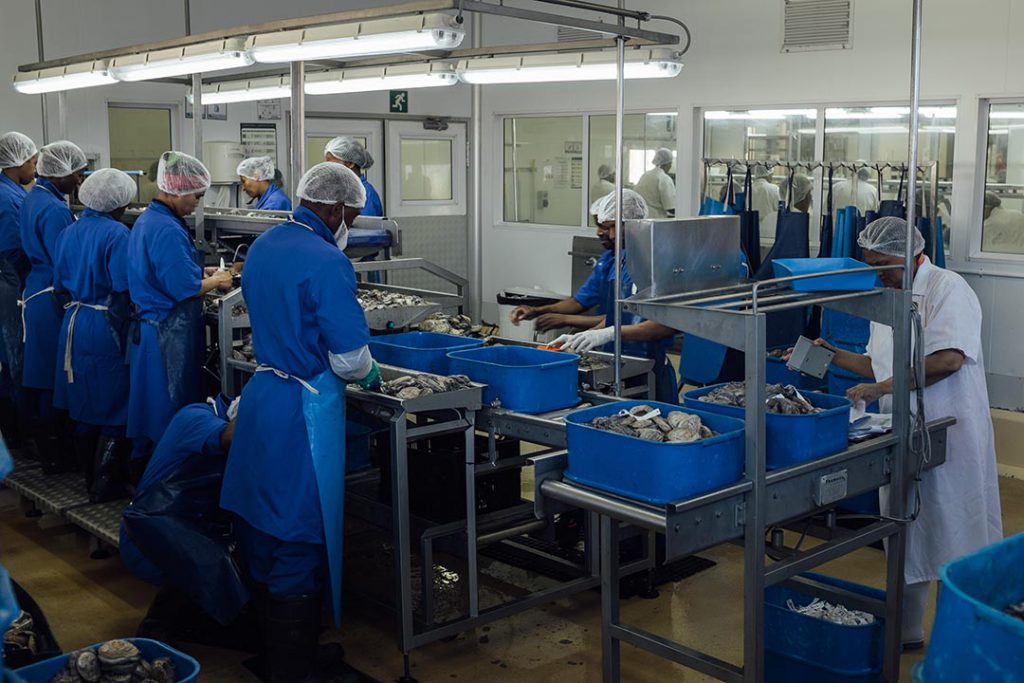
Growing industry: Workers at Abagold’s processing facility handling fresh abalone
Can farming be a solution?
The sizable overseas market for abalone and the vision of “sustainable fishing” have contributed to the growing aquaculture industry. “All of our abalone are farmed organically and fed with natural seaweeds. We do not add any chemicals during the processing stages,” said Werner Piek, marketing manager at Abagold, one of South Africa’s largest abalone breeders and exporters based in Hermanus, a coastal town on the southern tip of Western Cape.
“After we harvest the fully grown abalone, they are sent to the adjacent processing facility. They are cleansed, soaked, checked and canned there before being exported to various Asian countries,” Piek added. “Abagold is the only brand in the market that has the ‘Friends of the Sea’ certification.”
At present the total annual production of licensed farmed abalone in South Africa is about 1,500 tons, and Abagold accounts for one-fifth of that.
However, most conservationists tend to think that, given the current scale of the aquaculture industry and its high upfront investment costs, farmed abalone is still unable to compete with wild abalone in terms of price and volume.
“It is too early to tell whether it could be a viable way to repopulate the species by placing farmed abalone into the sea. Early studies reveal that these abalone cannot easily adapt to the complex marine ecosystems, nor successfully reproduce in the habitat. There are just too many variables involved in terms of the shift in habitat. More research is needed,” Burgener said.
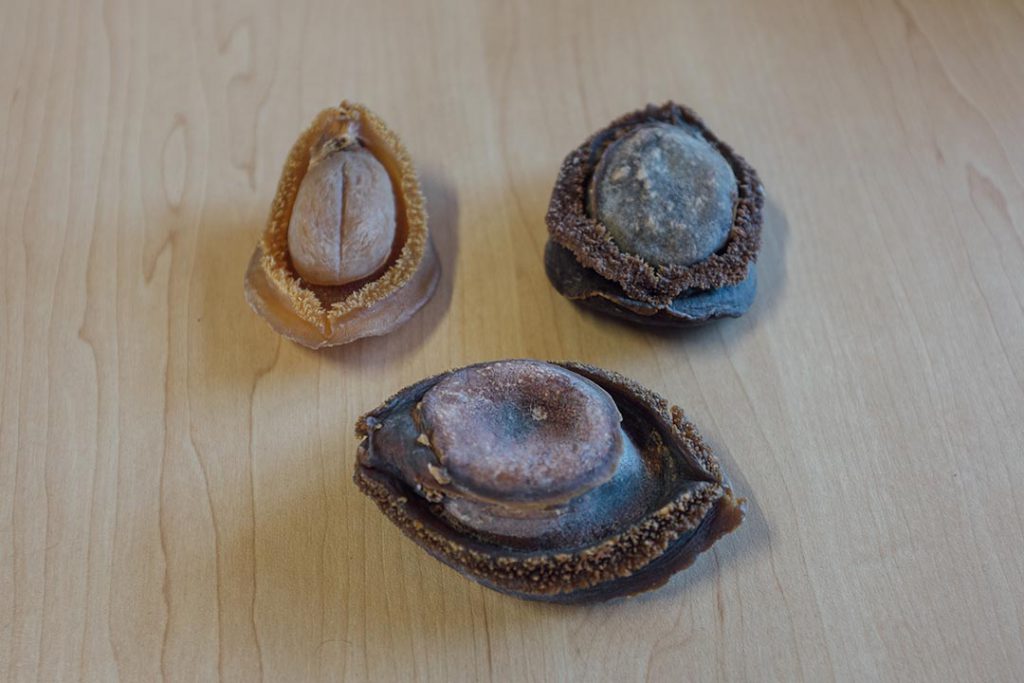
Werner Piek, marketing manager at Abagold, believes consumers can tell if abalone are legally imported from their appearance, colour and odour. In this photo, the abalone at top left is legal, the others are illegal
What can Hong Kong do?
What role does Hong Kong have, while sitting at the heart of abalone trading?
Piek believes a strict import labelling system would help consumers distinguish the sources of dried abalone. “All canned abalone exports must be legal since there are very rigorous licensing and inspection involved throughout the production. But the dried abalone are not regulated at all, and there is the loophole.”
Citing health concerns, Piek added: “Actually, one of the problems about illegal dried abalone is that they usually contain a considerable amount of inedible or even harmful chemicals. So if the Hong Kong government either requires all the imported dried abalone to be provided with health certificates, or requires the local distributors to apply for environmental certificates, then a lot of illegal abalone would likely be unable to pass through customs in the first place.”
Piek also believes that the matter largely hinges on the willingness of the authorities in Hong Kong. “Of course we can push for things here in South Africa. But the problem is, if Hong Kong does not take the initiative and ask for it, there will not be much happening on our side.”
Yet the issue of smuggling South African abalone does not receive much attention from the Hong Kong authorities. A major challenge has to do with the laws: since the South African government has withdrawn the conservation status of primary abalone under the CITES regulations, the Hong Kong Agriculture, Fisheries and Conservation Department has no legal basis to curb smuggling of abalone.
In the past, the Hong Kong Customs had cooperated with law enforcement departments in South Africa on individual wildlife smuggling cases. However, in response to a written interview request, the authority said the relevant departments had “no figures available under this classification”, and the public could not access the trends and information of the relevant cases as a result.
What if the public seeks to consume less South African dried abalone? A dilemma remains. From the perspective of consumers, their price is among the most popular and stable; in the South African coastal fishing villages like Hangberg, abalone poaching is still vital to the livelihood of fishermen living in poverty.
“It reminds me of the British ‘Bobby on the beach’ – who is dedicated to his duty and the neighbourhood, and everyone comes to trust him. Now we need someone like him, as I sometimes really do not know who to trust,” the silver-haired Tannet lamented. His duty of guarding the coast is unlikely to end for the rest of his life.
At the other side of the coast, Louis took me to his backyard, where hundreds of empty abalone shells that he and his companions had captured during the week were twinkling in the sun. “We used to talk about the idea of the ‘Rainbow Nation’, where people are entitled to claim the land that belongs to everyone. It has not happened yet, but I guess I will keep waiting till I die.”
Find out how Chinese mining interests are killing off Namibia’s black rhinos, and related investigations in our Chinese smuggling links dossier
Crystal Chow’s investigation was supported by the Africa-China Reporting Project. Kimon de Greef also contributed to the investigation, which was originally published by The Initium Media in Hong Kong. Translation by Morrie Yu and Kelvin Chan
